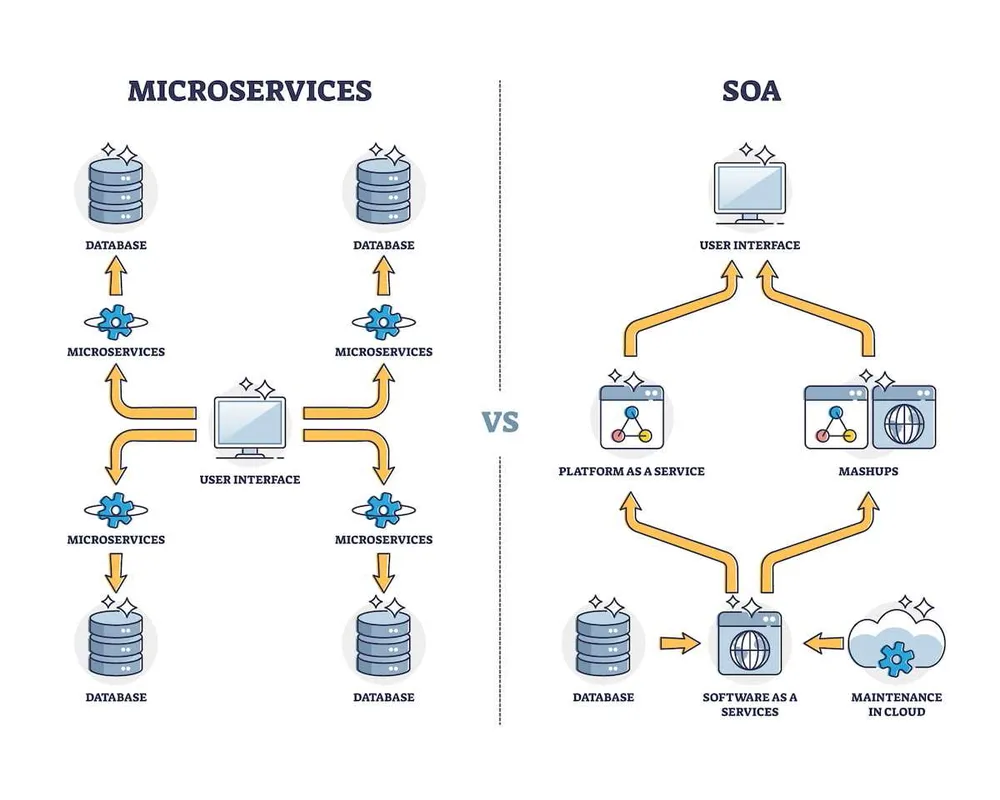SOA vs Microservices: An Overview of the Main Differences

When building a new product, development teams often have to circumvent the limitations of monolithic architecture and embrace a flexible approach to achieve enhanced scalability. Creating and launching pro-level applications necessitates embracing innovative procedures. Utilizing service-oriented architecture (SOA) and containerization practices enables developers to create advanced solutions with extensive functionality and reduce the time to market by expediting all the product development stages. In this guide, we will compare SOA vs microservices, explore their applications, and consider which solution is best suited for businesses.
What is SOA?
SOA is an innovative approach to programming based on the usage, testing, and deployment of autonomous modules. It facilitates building top-grade products with many components. There are four types of units supported by SOA:
- Functional modules are necessary to deploy apps.
- Enterprise services are utilized to create specific features.
- Application services foster product development and deployment.
- Infrastructure modules heighten security, streamline authentication, and facilitate access.
SOA modules comprise three components, including the interface designed to optimize request management, the contract created to describe the relationships between a customer and provider, and the code.
Developers combine multiple modules when building complex apps with many elements. The SOA allows these units to be connected via the enterprise service bus (ESB) control layer. The architecture relies on loose coupling. Elements written in different languages and hosted on separate platforms are connected via the ESB.
The programmers use the features repeatedly across many products. They do not need to develop them from scratch when working on new projects. However, the significant shortcoming is that a tool with a bug may affect the performance of multiple apps if a company decides to deploy it across many products.

We are confident that we have what it takes to help you get your platform from the idea throughout design and development phases, all the way to successful deployment in a production environment!
What are Microservices?
Containerization solves the limitations of other approaches and permits programmers to produce edgy apps by breaking them down into parts. Each unit serves a certain business purpose. The microservices architecture is based on the principle of a bounded context. A module has limited dependencies and functions as an autonomous unit, meaning its failure won’t affect other features.
Modules communicate via an application programming interface (API). Coders link them via APIs to release easy-to-navigate products. It enables them to achieve better scalability, reduce errors, and avoid common limitations associated with SOA.
Top Reasons to Choose Cloud-Native Architecture
Before delving into the differences, it’s important to consider what advantages the procedures have and how developers leverage them to expedite their workflows. Below, we have rounded up some similarities between the methods. Both of them facilitate achieving the following tasks:
- Divide complicated apps into easy-to-manage elements;
- Enhance scalability to help teams build and release applications without delays;
- Leverage cloud environments to improve accessibility.
Despite the obvious upsides to using both methods, there is nothing similar in the scope of their application, the governance principles they are based on, and the communication methods they employ. Understanding what distinguishes them is the first step toward achieving desired objectives.

SOA vs Microservices: What Sets Them Apart
Before making a choice, it is feasible to focus on the architecture scope. When using SOA, experts reuse tools across many apps. The utilization of containerization implies that standalone units function independently.
While SOA has an enterprise-level scope, component-based programming is preferred by many coders for the application-level scope. Due to this notable distinction, such approaches differ in multiple areas:
- Reusability: SOA empowers professionals to use modules multiple times to speed up their workflows and improve scalability. Engineers inclined toward decoupled frameworks criticize the approach, as they believe it results in poor agility and a high number of bugs. They reuse only duplicate data to ensure the independent functioning of each feature.
- Synchronous protocols: In SOA, services become available via RESTful API and similar protocols. Due to the concerns about the reliability of such systems, programmers who rely on microservices use event sourcing and a publish-subscribe messaging pattern to establish asynchronous communication, resulting in enhanced performance.
- Data usage: SOA implies receiving data and keeping it updated at the source level. The key shortcoming of this method is that it results in establishing dependencies between units even if no advanced data synchronization approaches are used. The API-driven model facilitates getting local access to data, which enables developers to avoid dependencies but results in data duplication.
These differences heighten the fact that these approaches are suitable for different tasks. Choosing the right architecture necessitates setting development goals and devising a viable strategy.
Which Option is Best Suited for a Business?
The final choice of models depends on the available resources, strategic goals, the state of IT infrastructure, and a company’s specific needs. An enterprise should start by analyzing its structure, goals, and areas of expertise to make the right decision. Large app environments are more suitable for implementing SOA. It supports enhanced connectivity via the ESB and allows teams to connect apps using various protocols.
Deploying systems based on SOA is time-consuming as it requires the developers to deploy the whole app after adding a new feature. After taking a closer look at service oriented architecture vs microservices, it becomes obvious that the former is better suited for the following tasks:
- Streamlining communication between apps
- Building features that an enterprise plans to reuse
- Utilizing multiple data sources for a single app
- Making data and features accessible to external clients
- Developing serverless functions
In contrast, the distributed systems are suitable for coders who want to build products faster. It lets teams optimize their processes, as each unit is built to correspond to a specific business capability and can operate independently. Companies that opt for smaller environments and do not need to access a powerful communication platform often opt for this approach, as it allows them to reduce expenses and streamline workflows.
When trying to collate SOA vs microservices, keep in mind that the latter facilitates achieving the following objectives:
- Make it easier to finalize simple projects
- Split large apps into multiple parts
- Create containers to optimize cloud computing resource usage
- Utilize different frameworks in a single environment
If a company relies on monolithic architecture, SOA may seem like a step toward embracing an agile approach. Determining what method works best requires analyzing the complexity of an app domain. Both models rely on automation, but SOA is mostly deployed by enterprises that lean toward large environments.
Recommended Use Cases
When considering cloud based software development practices, an organization should consider the applications it mostly works with. Large legacy systems are easier to manage using SOA. This model lets developers access pools of shared resources to optimize processes and avoid building redundant features.
Event-driven architecture is perfect for agile teams that want to change code without impacting an app’s functioning. The professionals who adopt this approach utilize a variety of languages and libraries when working on a single project and can scale individual units.
This SOA vs microservices comparison demonstrates the importance of choosing the right option to achieve tangible results. However, implementing such models is arduous without strong technical skills. The Global Cloud Team includes professionals with years of experience who utilize both approaches effectively. We know what solutions help our clients achieve their goals. Contact our specialists today and discover how to develop advanced systems.
Top Articles
Container vs VM (Virtual Machines): How Do They Differ?
I am here to help you!
Explore the possibility to hire a dedicated R&D team that helps your company to scale product development.






